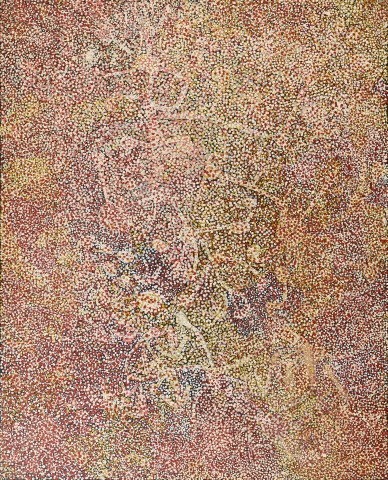ANOORALYA (WILD YAM), 1989
EMILY KAME KNGWARREYE
synthetic polymer paint on linen
150.0 x 121.0 cm
bears inscription verso: artist's name and Delmore Gallery cat. B154
Delmore Gallery, Alice Springs
Private collection, Melbourne
Emily Kame Kngwarreye, Paintings from 1989-1995, Works from the Delmore Collection, Parliament House, Canberra, 7 November – 3 December 1995
My Mother Country, Malerei Der Aborigines, Kunsthaus Zug, Switzerland, 29 Sept 2019 – 10 Feb 2020
Isaacs, J., Smith, T., Ryan, J., Holt, D., and Holt, J., Emily Kame Kngwarreye Paintings, Craftsman House, Sydney, 1998, p. 46, pl.3 (illus.)
Emu Story, 1989, synthetic polymer paint on canvas, 150.5 × 122.0 cm, in the collection of the National Gallery of Victoria, Melbourne, illus. in Isaacs, J., Smith, T., Ryan, J., Holt, D., and Holt, J.,Emily Kame Kngwarreye Paintings, Craftsman House, Sydney, 1998, pl. 2, p. 45
‘All the paintings of Emily Kngwarreye, so spectacular and diverse in style, express a central theme – that of her identification with the earth and land itself: Anmatyerre country, the country of the yam and the emu’. 1
When describing the first paintings on canvas produced by Kngwarreye such as Anooralya (Wild Yam), 1989, Judith Ryan sees a connection to, as well as an evolution from her earlier batiks, noting that these canvases ‘retain the linear network as an underlayer or foundation, but the dots that were subsidiary in her batik come to the surface … lines and dots converge in a dense field of irregular textured marks which create a sense of depth.’2
Janet Holt records in the accompanying certificate from Delmore Gallery that Anooralya (Wild Yam) was the eleventh canvas painted by Emily Kame Kngwarreye at Delmore Downs Station in 1989.3 A significant early work, the surface is replete with a full complement of the artist’s stylistic elements. Painted on a black ground, the underlying tracery of milky lines signifies the meandering roots of the yam below the earth and the tracks of the travelling emu moving between nesting sites above. The underlying pattern is covered by layers of dots painted in a traditional palette of earth colours; red, yellow and white, which represent the blanketing of seeds, flowers and leaves. Fundamentally, this work depicts the relationship between the emu and country. Beneath the soil the bush yam is ready for digging, while above, there is a flurry of movement as the male emu moves across the landscape feeding on various seeds, simultaneously shepherding his chicks into areas where the yam thrives.
The importance of Emily Kngwarreye in the history of twentieth century Australian art cannot be overstated, the body of work produced in the final stage of her life radically altered the way in which we view and appreciate modern Aboriginal art. Stemming from a lifetime of making art, where the visual and performative aspects are as important as language, her paintings reveal a deep affinity to country and a devotion to women’s ceremony in song, dance and the ceremonial painting of bodies. Celebrating the ever-changing seasonal variations in her homeland of Alhalkere and the related spiritual and domestic obligations to country, Kngwarreye’s painting demonstrate the interconnectedness of life, landscape and culture.
1. Isaacs, J., ‘Anmatyerre Woman’ in Emily Kngwarreye Paintings, Craftsman House, Sydney, 1998, p. 12
2. Ryan, J., ‘Emily Kngwarreye in the National Gallery of Victoria’ in Emily Kngwarreye Paintings, ibid., p. 79
3. From the accompanying Delmore Gallery certificate of authenticity
CRISPIN GUTTERIDGE
